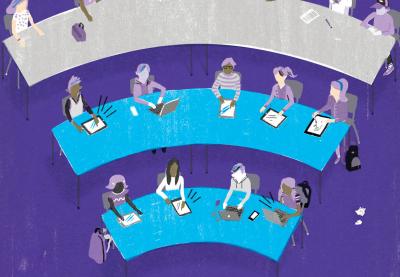The Pew Research Center’s Internet & American Life Project recently asked over 1,600 experts what they thought the future of the Internet would look like. Respondents replied that the Internet would essentially become the equivalent of electricity—something so integral to our daily lives that it is practically invisible.
Compelled by a similar vision of the future and the increasingly technology-driven nature of our society, more and more U.S. schools are adopting “bring your own device” (BYOD) policies, encouraging students to bring personal computers, tablets, mobile phones and other Internet-compatible devices to class to serve as learning aids. According to the 2014 Digital School Districts Survey, conducted by the Center for Digital Education and the National School Boards Association, the percentage of schools using BYOD has jumped from 34 to 56 in just the last year.
So why BYOD instead of “one-to-one,” a system in which schools provide one device per student?
“Fundamentally, it’s school finance,” says Julie Evans, chief executive officer of Project Tomorrow, a California nonprofit that promotes innovation in math, science and technology education. “Administrators have bought into the idea that having a personalized computing device in the hands of every student is a good idea. But they have not been able to figure out how to pay for that on an ongoing and sustainable basis. In many cases—in most cases—they have backed into BYOD as a solution to that problem.”
BYOD is, on the surface, the most cost-efficient approach to integrating technology into schools. But while some schools and districts have warmly embraced it, many educators worry about the potential for inequity: Some kids can bring better technology from home than others, and some can’t bring any at all.
Elliot Soloway, a University of Michigan professor who specializes in technology in education, says, “It’s a Band-Aid that makes people feel good, but you’ve got to ask the hard questions.”
Approaches to BYOD
Soloway observes that BYOD schools fall into three main implementation categories and that these categories fall largely along economic lines.
The first category includes schools with the financial resources (tax base and community support) to absorb the cost of software, training for teachers, curriculum overhauls that integrate the devices and—crucially—enough backup devices to cover students unable to bring their own.
The second category is made up of districts with shakier budgets. These schools really can’t afford a robust implementation framework for BYOD like the schools in category one, but they sacrifice to at least find money for backup devices.
The third category is where schools with high free- and reduced-lunch populations often find themselves. They have problems similar to those in the second category, but those problems are more acute. Even with BYOD, these schools can only provide adequate technology through fundraising. This category is at the highest risk for child-to-child inequity because of the limited capacity to fill the gap if families or fundraising cannot provide needed devices.
What educators spanning all three categories discover is that, while BYOD saves money initially because schools don’t have to purchase expensive devices for every student, implementing it still comes with an array of financial and social costs.
The Financial Cost
One of the biggest costs is infrastructure. Superintendent Gail Haterius, who leads the school district in Mineral Wells, Texas, knew that fast Wi-Fi was critical for BYOD to work. “The only perk I can give my teachers is that we can let them use the Wi-Fi for personal things before school, after school and at lunch,” Haterius says. Most of the district’s schools are in good shape, but the Wi-Fi systems at two schools have struggled under the unexpectedly heavy load created by BYOD, requiring a $325,000 upgrade.
High-quality implementation of BYOD also requires professional development. Jennifer Drake Sullivan, media coordinator at New Bridge Middle School in Jacksonville, North Carolina, emphasizes that teachers must be trained to cope with the lack of uniformity among students’ devices. “It’s not the same thing as having a classroom full of laptops or tablets,” she says, “because they don’t all have the same connectivity or ability to do certain projects. That part is frustrating for some teachers who really want to use technology.” Budgeting for this cost may be impossible for schools in category two or three who may struggle to even pay the Wi-Fi bill or provide backup devices.
And, while inadequate funding for public schools is one of the main drivers of BYOD’s popularity, that same lack of funding prompts many schools to scrimp on one of the most important aspects of implementing BYOD effectively: revamping the curricula.
It's a Band-Aid that makes people feel good, but you've got to ask the hard questions.
“In a lot of cases, all you’re doing is supplementing the existing curriculum with a little technology,” Soloway says. “The data says you will not see increases in student achievement under those circumstances. Student achievement is associated with using devices as essential tools.” For example, instead of having students read a chapter on the solar system and answering questions about it at the end, a lesson designed with BYOD in mind might have students use their devices to research the solar system, create their own questions about it and research the answers to each other’s questions.
Still, overhauling curricula to maximize the use of personal devices is costly, both in terms of dollars and staff time.
Digital Community by Alissa Sklar
Implementing a BYOD policy is the perfect opportunity to emphasize digital citizenship as part of your school’s culture.
Set up clear guidelines. Schools need to inform students and families about when devices can be used, who is responsible for damage and what the consequences will be if devices are misused.
Talk about empathy and community. Defining your school’s expectations of digital citizenship goes a long way towards avoiding problems. Integrate concepts of safety, rights and respect for self and others—online and elsewhere—into classroom activities and homework. Check out this example of proactive, pro-technology guidelines from the Trafalgar School for Girls in Montreal, Quebec.
Teach about privacy controls. It can be tempting to trade privacy for high follower counts on Instagram, Tumblr or Twitter, but this leaves students open to cyberbullying, trolling, identity theft and the possibility that their digital footprints can come back to haunt them. Consider asking students to research privacy settings as part of an assignment.
Emphasize that passwords are personal. Sharing passwords is too often viewed as a sign of trust in a relationship or friendship, but true friends would never ask you to divulge this information and make yourself vulnerable.
The Equity Cost
BYOD poses social emotional risks to students as well. Dyanne Schoterman, former principal at Elizabeth Price Elementary in Cuyahoga Falls, Ohio, says she witnessed the toll of inequity during a school assembly in the gym. Shortly after Price Elementary had adopted BYOD—but had yet to provide devices for all kids—Schoterman allowed students to bring personal devices so they could play games, such as Minecraft.
She regretted that decision as soon she looked around the gym. The kids with devices were busily playing, huddled in groups. Those who couldn’t join in were left to look over shoulders or go reluctantly to do other activities. “It was right in front of me,” she said. “There were the haves and the have-nots.”
While some students not having a device is clearly inequitable, Sullivan does note that, in the six years she’s used BYOD, she’s never seen a kid adopt a superior attitude because he had a better device than another kid. “It’s not like the high-dollar sneakers,” she says.
Steven Baule, superintendent of North Boone public schools in Illinois, agrees, but his concern lies in what the students can accomplish academically with their respective devices. Students with iPads can obviously be much more creative—and learn much more—than those who can bring Internet-compatible gaming devices only. As a result, Baule notes, his colleagues are uncomfortable assigning technology homework. “Even in an affluent school district there are still some kids who don’t have access to the things they need,” he says.
Soloway says one of the things kids need most is connectivity when they’re away from school, and many programs and districts are working to make that happen. In 2011, the U.S. government moved to help with the Connect to Compete program. Families with one child participating in the National School Lunch Program may be eligible for discounted $9.95 broadband Internet access, a refurbished computer and free digital literacy training. Meanwhile, some districts have begun providing low-cost mobile wireless devices to low-income students so they can access the network at home.
Doing BYOD Right
The capacity to implement BYOD is something each school’s staff must evaluate for itself; in all cases, equity should be a central consideration. Educators who follow best practices for using BYOD effectively and equitably in their classrooms offer the following suggestions:
- Make sure the infrastructure is there. If your school isn’t planning to upgrade its Wi-Fi system and designate an IT specialist, BYOD implementation is probably headed for trouble. Talk to superiors about anticipating the bandwidth BYOD will likely demand.
- Provide backups. Even students who have devices may lose or break them or become targets of theft. Teachers need to know they’ll have enough devices for their lessons. This may require creative budgeting and fundraising outside the school.
- Set up an equity task force. This group can be composed of teachers, students, parents and community members. It should identify whether students are being left behind by BYOD and find realistic ways to include them. The biggest challenges the task force can expect to face are fundraising for backup devices and finding out-of-school Internet connections for low-income students.
- Make teacher training a priority. BYOD requires creative teaching, Sullivan says. “Give them ideas about what they can do with it so when they have those 30 different devices [in class], they can make it work.” Teachers who get no training or poor training often just stop using the technology completely. Schools that have already implemented BYOD are potential professional development resources.
- Include students in BYOD planning. Students are understandably enthusiastic about using personal devices in school. They are also resourceful, creative and tuned in to both the technology and social aspects underlying BYOD implementation challenges. Ask them what they think.
BYOD policies will continue to challenge educators as long as funding deficits in public education persist. Many educators who’ve worked with BYOD say it can provide real benefits in schools when school leaders are conscious of its drawbacks and find creative and equitable ways to address them.

